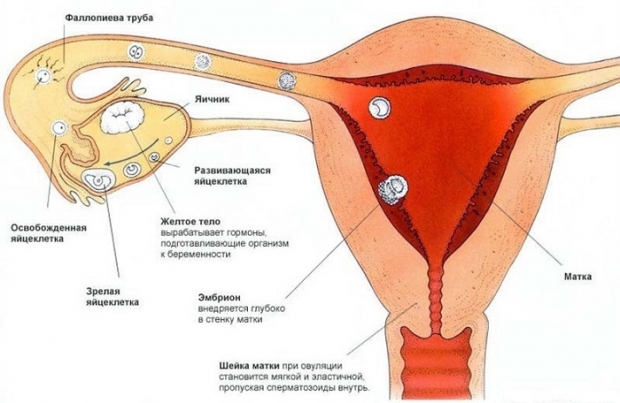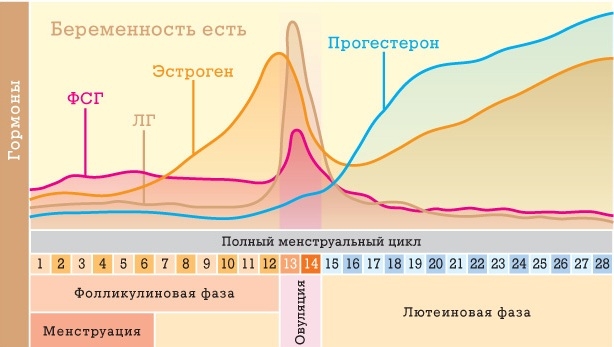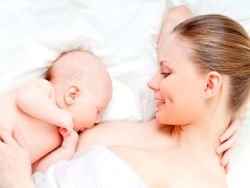Signs of pregnancy during lactation. ovulation after childbirth
The content of the article:Happy and, at the same time, tortured new mothers do not think at all about when ovulation occurs after childbirth, which is the key to restoring reproductive function. However, this process can threaten fertilization, which is often not expected. Therefore, it is very important to have information on how the menstrual cycle occurs after childbirth, and how to avoid unwanted pregnancies.
How many days after birth does ovulation occur?
With the usual menstrual cycle, ovulation falls in its middle. However, in practice, there are exceptions to this rule. After giving birth, everything in the hormonal life of the mother changes completely. On average, ovulation after childbirth occurs on the 45th day after the baby is born. But, it is worth noting that the interval between delivery and the release of an egg from the follicle can vary from 25 to 72 days, depending on individual characteristics. female body. That is why, you should not forget about contraceptive methods, even at a time when it seems to you that conception is impossible.

How to calculate ovulation after childbirth
With an unformed menstrual cycle, calculating the exact date of ovulation after childbirth on your own is an impossible task. However, this works:
Tests. Newly-made mothers can examine the level of hormones in the urine using special strips purchased at the pharmacy, especially when all signs of ovulation are present;
- chart of basal temperatures. This method, although one of the most accurate, is not the most comfortable. Its essence lies in the daily measurement basal body temperature, the jumps of which indicate the onset of ovulation. However, it is worth noting that a woman should carry out this procedure in the morning without getting out of bed;
- ultrasound examination. In the above period of onset of ovulation after childbirth, 2-3 ultrasound examinations can be done. A qualified specialist with the help of hardware diagnostics can easily determine the exact date of ovulation.
Ovulation after childbirth at the end of the cycle
In the practice of specialists, there are cases when fertilization occurs at the end of the cycle, before menstruation. Often this process is observed in women after childbirth. After all menstrual cycle is just starting to recover. In such situations, there may not be a delay during the second menstruation after childbirth. A fertilized egg is simply initially located for a certain period in the tube, and only before the next cycle, it passes into the uterus.

Ovulation while breastfeeding
According to statistics, the resumption of the menstrual cycle with breastfeeding within six months after childbirth occurs only in 7% of women. This is due to the presence in the body of a nursing mother of the hormone - prolactin. However, after 6 months, modern women begin to feed the baby with various cereals and mashed potatoes. As a result, the amount of hormone production begins to decline sharply. As a result, ovulation is fully resumed after childbirth with HS and the menstrual cycle, in general.
How can childbirth affect ovulation?
Quite often there is painful ovulation after childbirth, especially after caesarean section. Unpleasant symptoms are a consequence of the hardening of the ovarian membrane, as a result, the egg simply has to break its way. Internal hemorrhage characteristic of this process, irritates not only the uterus, but the entire intestine. As a result, there are painful sensations throughout the abdominal cavity.
Ovulation after childbirth without menstruation
The resumption of the predisposition to fertilization after childbirth occurs as a result of the restoration of the ovulation process. However, it is not always followed by the usual bleeding. Counting on breastfeeding as a method of contraception, or the absence of menstruation, women allow themselves to have unprotected intercourse. As a result, the likelihood of an unwanted pregnancy increases. In some cases, it comes as early as 6-8 weeks after birth. It is not difficult to guess what another pregnancy can be fraught with for a weakened body.

Signs of ovulation in the postpartum period
The onset of ovulation depends on factors such as the duration of breastfeeding and genetic factors. Cases are not excluded when the restoration of reproductive function is observed only after the return of a full menstrual cycle.
To recognize ovulation in the postpartum period, the following sensations and symptoms will help:
1) abundant vaginal discharge - during the release of the egg from the follicle, they become more viscous;
2) a feeling of discomfort in the abdominal cavity. During the period of ovulation, aching pain in the lower abdomen is noted, which is often accompanied by excessive gas formation and bloating;
3) painful chest. The onset of ovulation after childbirth is always accompanied by a change in the hormonal background, which is reflected in an increase in the sensitivity of the mammary glands;
4) increased sexual desire. This instinct is provided by the nature of the female body, so as not to miss the moment of conception.
When does the full recovery of the menstrual cycle occur?
Ovulation after childbirth with menstruation occurs for each female body in different ways. The recovery period of the cycle in nursing mothers can vary from 6 months to 2 years of the baby. However, in 8% of women, sometimes, the duration of the return of menstruation exceeds 2 years. Everything again depends on the individual characteristics of the newly-made mother.
So, for example, if earlier a woman could not worry about the onset of pregnancy for the entire period of lactation, today the reproductive function is able to resume during breastfeeding. The reason for this is stress, ecology, temporary use of contraceptives.
Most women after childbirth believe that if there is no menstruation, then it is impossible to get pregnant. However, the above information refutes this theory. Therefore, contraceptive methods should not be forgotten even after childbirth.
The children of the weather are, of course, wonderful. But, if you are not going to "sit out" in maternity leave for a couple more years, do not forget that breastfeeding pregnancy (HB) even without menstruation is more than a reality. And there are no miracles and accidents here - everything is subject to the natural biological cycle of a woman.
But still, when can pregnancy occur after childbirth while breastfeeding, and what are its signs? -Let's discuss.
When can you get pregnant with HB?As a rule, the first two months after childbirth, a woman goes to restore and improve lactation. If the child eats the breast on demand both day and night, then most likely the first menstruation of the mother will go no earlier than six months later. But this is only an assumption, since the ability to conceive for each woman returns at different times. It often happens that a lactating sexually active mother, due to the lack of menstruation, believes that she cannot become pregnant. But this opinion is erroneous, since the egg in any case will mature before the first discharges go. Therefore, the likelihood that the first ovulation after childbirth will be the last for at least another 9 months is extremely high.
Signs of pregnancy while breastfeeding without menstruation
It is possible to suspect pregnancy during breastfeeding without menstruation by classical signs, but most likely the baby will be the first to react to the changes that have occurred. The fact is that changes in the hormonal background will affect the taste, texture and quantity of milk. Therefore, the first sign of pregnancy after childbirth during breastfeeding and the reason for doing the test can be considered the sudden refusal of the baby from the breast. Also, a sharp decrease in the amount of milk can signal conception. This phenomenon is associated with the redistribution of resources in the mother's body.
In general, the symptoms of pregnancy with hepatitis B are not much different from the usual signs.  These are morning sickness, weakness, malaise, changes in taste preferences, dizziness and headaches - all these "charms" can manifest themselves to one degree or another. If a woman already had menstruation after childbirth, then her absence in due time should alert. But the mammary glands can be misleading. In particular, the characteristic soreness of the breasts and nipples, which often signals an interesting position, often occurs as a result of improper attachment of the baby to the breast,
These are morning sickness, weakness, malaise, changes in taste preferences, dizziness and headaches - all these "charms" can manifest themselves to one degree or another. If a woman already had menstruation after childbirth, then her absence in due time should alert. But the mammary glands can be misleading. In particular, the characteristic soreness of the breasts and nipples, which often signals an interesting position, often occurs as a result of improper attachment of the baby to the breast,
After childbirth, the body of the mother begins to intensively produce oxytocin: a special hormone. Normally, it is always present in small amounts in the body of a non-pregnant woman. But it is this hormone that is responsible for the contraction of the uterus after the appearance of the baby, and for the production breast milk he answers too. The more often the mother puts the baby to the breast, the more the hormone is produced and, as a result, milk.
Oxytocin in large quantities provokes lactational amenorrhea - the absence of menstruation. No menstruation means no ovulation, no ovulation means no egg ready for fertilization. In some women, amenorrhea lasts for several years, and in some - only a few months (sometimes not at all). But can a woman predict that amenorrhea is over? After all, the most obvious sign that a nursing mother can become pregnant again is menstruation, but it comes a couple of weeks after ovulation and possible fertilization. And a sexually active breastfeeding mom can get pregnant on the very first ovulation without even knowing it.
Signs of pregnancy while breastfeeding
If the mother is feeding, but her cycle has already been established, then the symptoms of pregnancy with HB will be clearly familiar to her: the absence of menstruation on time and other possible accompanying signs - malaise, nausea, intolerance to certain foods and odors. But how can a nursing mother understand that she is pregnant if she has never had a period after giving birth?
1. The first sign: a change in the quantity and quality of breast milk due to hormonal changes. As a rule, there is less milk, and the child notices that it has changed in taste, and may suck reluctantly or refuse to eat at all. At the same time, the chest begins to hurt in a completely different way than from rushes of milk; often it noticeably increases and swells.
2. The second and most reliable sign: a positive pregnancy test. If you suspect that another child is growing in the mother’s tummy, you should immediately use the home express method for determining pregnancy, because hCG rises in the urine, regardless of whether the pregnant woman is breastfeeding or not. How to determine pregnancy with HB with one hundred percent probability? Pay a visit to your gynecologist.
Breastfeeding and pregnancy: are they compatible?
Gynecologists recommend maintaining an interval between pregnancies of at least two years. The body has not yet recovered from childbirth, lactation is also a big burden on the body, and a new pregnancy is a huge stress for it. But if another baby is a joy for the whole family, then you should not refuse it.
In the end, the weather is great! And many women manage to maintain lactation during pregnancy. However, this pregnancy will require constant monitoring by the attending physician, and a woman should be prepared for possible complications (including premature birth).




